The trend towards greater extravagance in dress, found in the 11th -13th centuries, increases throughout this whole period. Several factors were at work pushing high fashion towards greater and greater consumption: increased exports from the East in the wake of The Crusades, increased production and improved quality of textiles in the West, the wealth of a rising urban tradesman class, and the sudden increased inherited personal wealth of the survivors of the Black Plague (1350-1400).
In Italy these factors operated at a peak because fine fabric production and importation was the cornerstone of the Northern Italian economy. Huge fortunes were made in the Florentine and Venetian city republics by merchants and manufacturers who had no lands or titles with which to claim nobility. These wealthy merchants sought out a way to buy the status that they craved. With fabric as their stock in trade they dressed more lavishly than the landed nobility, and spent fantastic sums on private and public art and architecture to gain social recognition

Young Venetian Gentlemen of the 15th Century from Stibbert
The competition in dress took a new twist in this period. Once one has enough gowns and surcoats in the finest fabrics, and all your peers have the same, how do you compete? Conspicuous consumption will only take you so far, you can only wear one set of clothes at a time. This is when Western dress took it's long trip into fashion and fads. The Italians began to take fabric and cut it and piece it in a complex fashion to fit close to the body, and have a recognizable "cut" that could be adopted and discarded as a "fashion". By combining the intricate cut, piecing and fit usually found in skin-sewn cultures and applying it to fabric, the Italians acquired the means to make clothing with a planned obsolescence. This meant that (as now) clothing could go out of fashion faster than it would wear out. This put anyone, even an aristocrat, without the means to continuously buy new clothing in a place somewhat lower than that of the very rich.
Northern Europe to a lesser degree went through a similar change at this time. Many villages and small towns grew into cities in this period, buoyed up by the wealth that the tradesmen who lived in them generated. Cities did not fit into the feudal social structure of the time, and so had to develop social structures of their own. Not surprisingly they too adopted fashion as a marker of wealth and status, and the fashions of the cities came to be the fashions of the courts and aristocracy.

French women's headdresses of the 15th Century (Stibbert)
As a result this era had a lot of different fashionable garments and accessories in it, a number of which were quite extreme in style. Poulaines were long pointed shoes, worn mainly by men in Northern Europe, these shoes had padded toe points that could extend as far as a full foot length in front of the foot itself, and often present a rather phallic appearance.
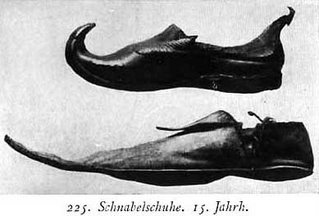
15th Century poulaines
Other fashion extremes included the Hennin, a woman's conical headdress popular in Northern Europe of the 15th Century, The Chaperon, a turban like headdress worn in Italy and the North, The Houppelande, a graceful unisex gown which used an amazing quantity of fabric both on the body and trailing on the ground, and parti colored dress, a fashion of piecing many different fabrics together into a single garment, and then there is the Codpiece a padded section of a man's hose intended to contain the sex organs.
Both in the North and in Italy, dress got progressively longer, and more vertical in line as the 15th Century went on. By 1500 upper class dress is heightened by headdress, lengthened with trains and hanging sleeves, and appears to be drawing an obvious parallel with the verticality of the late Gothic religious architecture of the time.
Grand seigneur wearing a houpplande and chaperon, c.1410
Great ladies c. 1450 wearing hennins
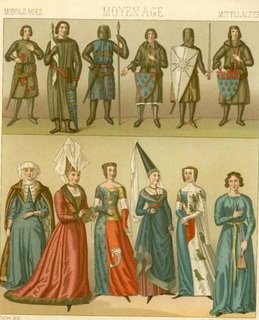
12th-15th Century French dress from Racinet.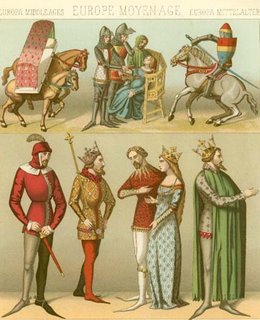
12th-14th Century men's dress from Racinet.
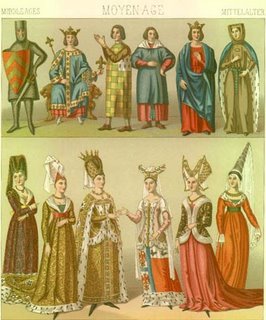
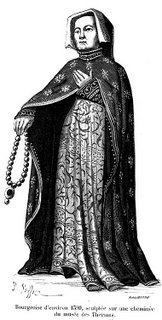
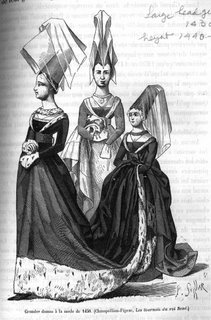

No comments:
Post a Comment